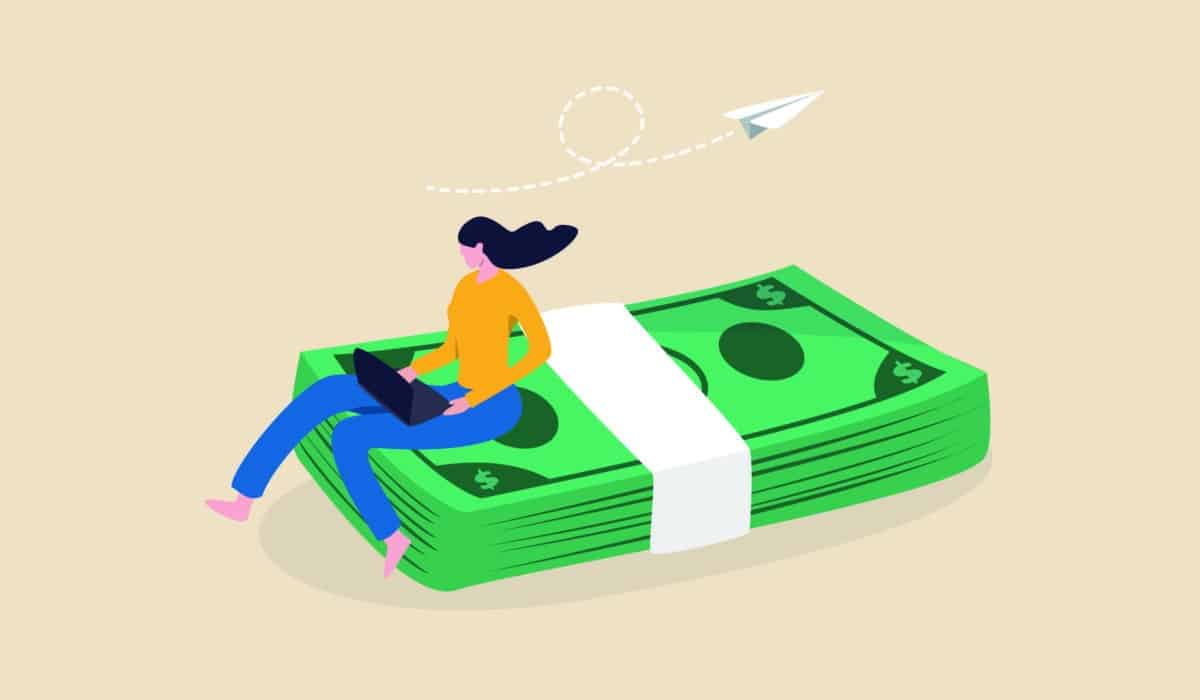Have you ever ordered an item on Amazon and been offered a discount if you’ll instead subscribe to receive that item every month? If so, you’ve witnessed the trend towards converting one-off sales into recurring revenue.
The recurring-revenue business model is highly popular, and for good reason. Recurring revenue offers distinct advantages for owners, both while you operate your business and when you’re looking to sell your business for as much as possible.
I experienced this myself when I sold a community for writers, Freelance Writers Den, in 2021. The business was more valuable to buyers because it was built on recurring revenue: members paid a monthly fee to remain in the community.
In fact, in the two years immediately prior to the sale, I shifted the focus to primarily selling community memberships rather than one-off courses or coaching, knowing that the recurring-revenue side of the business was of more interest to buyers.
Why do buyers offer a higher valuation for recurring-revenue businesses? And could this model be a fit for your business? We’ll explain, plus offer a few examples of recurring revenue businesses.
What is recurring revenue? And why is recurring revenue important?
Recurring revenue is business income that happens on a regular basis due to customers’ commitment to an ongoing subscription. These recurring payments might occur every month, quarter or year.
In a recurring-revenue business, customer payments automatically renew until the customer takes active steps to cancel. This tends to create long-term customer relationships, since the relationship is set to continue on autopilot.
One reason business buyers want to see recurring revenue is that this makes it easier to estimate future cash flow, said James Robertson, partner in the business entities and transactions practice at the law firm of McDonald Carano. It’s also a quick measure of the business’s general health.
“You see a lot of buyers almost exclusively looking for some kind of recurring model,” Robertson said.
In a recurring-revenue model, there’s usually available data on how long a typical customer stays with their subscription. That means it’s easy to calculate customer lifetime value (LTV). The buyer knows both how attrition will impact income, and also how revenue would grow if they increased marketing and found new customers.
“Recurring revenue indicates predictability,” Robertson said. “It’s a proxy for growth, and shows there’s a proven concept and demand for the offering.”
Another big reason for recurring revenue’s popularity is that buyers can use those revenue forecasts to obtain financing to buy the business, Robertson said. With recurring revenue, banks are more easily convinced that a loan would be low risk. There’s predictable future cash flow to help make the loan payments.
If a business relies entirely on one-off transactions, there are no guarantees of any future income — a much riskier proposition for a lender.
What is annual recurring revenue (ARR)?
There are a few different types of recurring revenue, including annual recurring revenue (ARR) and monthly recurring revenue (MRR).
When customers sign up for an automatically renewing contract that they pay for in a single payment collected once a year, that income is known as annual recurring revenue.
Annual subscriptions can be advantageous if your data shows many customers would cancel quickly on a monthly plan and not stay an entire year (a problem also known as ‘high churn’ or turnover rate). If that’s the case, an annual subscription model would likely result in more total revenue, noted Thomas Smale, founder of the global M&A advisory firm FE International.
What is monthly recurring revenue (MRR)?
When customers sign up for an automatically renewing monthly subscription, that income is known as monthly recurring revenue (MRR). Why might some businesses prefer MRR to annual plans?
Two words: cash flow. Big lumps of annual income may sound nice, but if all the revenue arrives in a single month, it can be hard to cover the regular monthly bills most businesses face, Smale pointed out.
This is one reason why a hybrid of MRR and ARR has arisen: The annual subscription that offers an option to pay the contract in monthly installments, usually at a slightly higher cost. It’s a win-win: the customer ends up paying a higher rate, and monthly cash flow is desirable to cover regular bills.
MRR can also work well if you have a price-sensitive audience or one with lower incomes. They might never pay $1,000 for an annual subscription, but $29 a month might feel doable. This was exactly the situation with my own community, which serves freelance writers, a notoriously low-income group.
So which is better: annual or monthly recurring revenue?
As you’ve seen, there can be advantages to both ARR and MRR subscription plans. The best approach for your business will depend on your churn rate, the cost of your subscription, your customer demographics, cash flow needs, and other factors. Smale recommends doing the math to see which approach is most likely to yield the most revenue.
Why buyers pay more for recurring revenue businesses
As you’ve seen, the predictable income and steady cash flow that recurring revenue provides makes this business model a safer bet for buyers. Attorney Robertson points out one other reason the recurring revenue model appeals to buyers: such businesses are also easier to vet.
In a business based on bespoke, individualized customer agreements, every contract must be reviewed during due diligence. In recurring revenue businesses selling a standardized offering, customers all sign the same agreement. The buyer can review that subscription language once and be good to go.
Examples of recurring revenue businesses that sold
How does selling a recurring revenue business work out?
Here are a few examples of recurring revenue businesses that recently sold:
Graphic design as a service: Where most graphic designers do one-off work for individual clients, Delesign built a monthly subscription design service to $90,000 MRR in under three years. The startup then found an undisclosed buyer for a near-7-figure sale.
Video testimonial capture: Applause Lab, which helped customers collect video testimonials, saw a 6-figure exit to Testimonial Hero in 2019, after building a book of 77 subscription customers.
Social media scheduling: Meet Edgar, a social media scheduling software, grew to several million in annual subscription-based recurring revenue before selling for 7 figures in 2021.
How to convert your business to the recurring revenue model
One industry that’s known for its success in using the recurring revenue model is Software as a Service (SaaS). But SaaS is not the only type of industry that can use a recurring revenue model.
In fact, almost any type of business can be adapted to bring in part or all of its revenue on the subscription plan, says Tyler Gillespie, a serial entrepreneur who now helps service businesses productize their offerings. Besides his video-testimonial business noted above, Gillespie also built and sold startups that used the subscription model for proofreading and content-writing services.
If your business currently relies on one-time sales, how can you make the transition to recurring revenue? It begins with thinking about how you could standardize what you do and sell it as a package that would work for many clients.
“A lot of people haven’t imagined what they do like a product,” he said.
Agencies, consultants and freelancers often do business with every client differently. By creating standard processes and procedures and a standardized offering, you make your business both easier to run and more attractive to buyers. Gillespie and others call this creating a “productized service.”
For instance, one of Gillespie’s coaching clients, Flight Financial founder and CEO Brian Zapf, transitioned his CFO consultancy to offer three streamlined packages to help B2B businesses optimize their financial reporting without having to pay a full-time CFO. “It’s driven substantial recurring revenue, compared to one-off consulting,” Gillespie said, and Zapf agreed.
Valuations for recurring revenue vs one-time sale models
While valuations vary widely based on the specifics of each individual business, as a general rule recurring-revenue businesses command a higher multiple of net income.
Gillespie noted that buyers often not only want to pay less for one-time sales models, but want an earn out agreement, to lower their risk around bringing in new sales without the founder. Converting your business to recurring revenue can lead both to a seller receiving a more favorable deal structure, as well as a higher-priced purchase offer.
“With one-off sales, it’s often a 1x-2x multiple with a one-year earn out, which isn’t ideal,” Gillespie said. “When you can change that to a recurring revenue model where you’re all of a sudden getting a 3x-5x multiple with no earn out, that’s pretty life-changing.”
Carrie Kerpen, who sold social media agency Likeable Media in 2021, said having 80% of the agency’s revenue on recurring retainers helped boost the valuation.
“Any buyer will want to see predictable revenue,” Kerpen said, “and they’ll pay more for an agency that delivers it. “
While project-based work is hot in the agency world, she recommends moving as many clients as possible to a recurring contract. One way she’s done that successfully is by itemizing costs as though they were a project, then bundling them together with a discount for clients who commit to long-term contracts.
Is recurring revenue always the best model?
If you’re excited to transition your business model to recurring revenue, advisor Smale suggests caution. First, figure out whether the move is likely to maintain or grow revenue. If your customers aren’t the type that would go for a recurring subscription, it might not work out.
“If you build a $1 million revenue business in one-time sales, and you could pivot that business to generate $200,000 in recurring revenue instead, the $1 million business is still worth more,” Smale said. “It’s not necessarily the best model for every business.”
For instance, one business owner Smale worked with explored recurring subscriptions and concluded he would make more by continuing to earn through website ads.
On the other hand, if you could convert your one-off sales-based $1 million business to a $1 million or more in recurring revenue, then it’s well worth making the switch, Smale said.
Another option is to find a segment of your business that you could convert to a recurring model, offering buyers some predictability. For instance, many consumer retail and e-commerce businesses that rely on one-off sales are now also offering monthly subscription boxes, noted Smale.
If the recurring revenue model isn’t for you, there are other ways to demonstrate repeat sales. If you have data that shows 75% of your one-time sale customers make a second purchase in the following year, this evidence of “re-occurring” revenue also strengthens your hand with buyers, said attorney Robertson.
But don’t make big changes to how you generate revenue in the months before you plan to sell. Switching to recurring revenue is best done several years prior to selling.
That’s because buyers will review about three years of financials, depending on the size of your business. A recurring revenue switch done right before you put your business on the block will have little impact on your valuation, said Smale. So if you want to sell and are considering moving to a recurring revenue model, remember that it pays to start that transition sooner than later.



